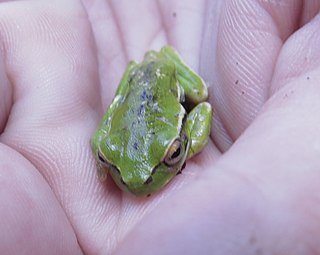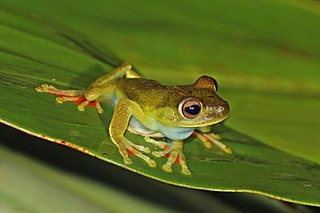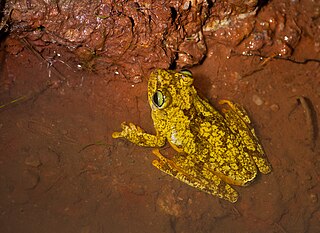
Boana is a genus of frogs in the family Hylidae. They are commonly known as gladiator frogs, gladiator treefrogs or Wagler Neotropical treefrogs. These frogs are distributed in the tropical Central and South America from Nicaragua to Argentina, as well as in the Caribbean.

The white-black tree frog is a species of frog in the family Hylidae endemic to Bolivia. Its natural habitats are subtropical or tropical moist montane forests, subtropical or tropical high-altitude shrubland, subtropical or tropical high-altitude grassland, and rivers. It is threatened by habitat loss.
The Cagua tree frog is a species of frog in the family Hylidae endemic to Venezuela. Its natural habitats are subtropical or tropical moist lowland forests, rivers, freshwater marshes, and intermittent freshwater marshes. It is threatened by habitat loss.

The Yungas tree frog is a species of frog in the family Hylidae found in Bolivia and Peru. Its natural habitats are subtropical or tropical moist lowland forests, subtropical or tropical moist montane forests, rivers, and canals and ditches.

The Charuplaya tree frog is a species of frog in the family Hylidae endemic to Bolivia. Its natural habitats are subtropical or tropical moist montane forests, rivers, and canals and ditches.

Gunther's banded tree frog is a species of frog in the family Hylidae. The species was re-delimited in 2014 and most of the earlier records assigned to this species refer to Boana maculateralis, Boana alfaroi, Boana tetete, and possibly also to an unnamed species. It is known with certainty only from the upper and lower montane forests on the western edge of the Amazon Basin in Ecuador and Peru, at elevations of 730–1,530 m (2,400–5,020 ft) above sea level.

The Los Bracitos tree frog, or Hispaniolan green treefrog, is a species of frog in the family Hylidae endemic to Hispaniola and found below 1,856 m (6,089 ft) asl. The species was named in honour of professor Angelo Heilprin who funded the expedition that this species was discovered on.
Hutchins' tree frog is a species of frog in the family Hylidae found in Colombia and possibly Brazil and Peru. Its natural habitats are subtropical or tropical moist lowland forests and rivers. It is threatened by habitat loss.
The Lema tree frog is a species of frog in the family Hylidae found in Guyana, Venezuela, and possibly Brazil. Its natural habitats are subtropical or tropical moist lowland forests, subtropical or tropical moist montane forests, rivers, pastureland, rural gardens, heavily degraded former forests, aquaculture ponds, and canals and ditches. It is threatened by habitat loss.
The Salta tree frog is a species of frog in the family Hylidae found in Argentina and Bolivia. Its natural habitats are subtropical or tropical dry forests, subtropical or tropical moist lowland forests, subtropical or tropical moist montane forests, rivers, freshwater marshes, and intermittent freshwater marshes. It is threatened by habitat loss.
Boana rhythmica is a species of frog in the family Hylidae. It is endemic to Venezuela and only known from its type locality, Cerro Jaua in Bolívar State. It occurs along streams on the slopes of the tepui. It is a nocturnal species found on branches of vegetation 0.3–1 m (1–3 ft) above the ground. The tepui is within the Jaua-Sarisariñama National Park, and no major threats to this species have been identified.

Boana riojana is a species of frog in the family Hylidae. It is found in the eastern Andes and the Andean foothills between La Rioja Province in Argentina and northern Bolivia, and possibly further into adjacent Peru. Common name Carrizo's tree frog has been used when referring to the formerly recognized Boana varelae(Carrizo, 1992).
Hoogmoed's tree frog is a species of frog in the family Hylidae found in Guyana, possibly Brazil, and possibly Venezuela. Its natural habitats are subtropical or tropical moist montane forests and rivers.
The Valle tree frog is a species of frog in the family Hylidae found in Colombia and possibly Ecuador. Its natural habitats are subtropical or tropical moist lowland forests, freshwater marshes, and intermittent freshwater marshes. It is threatened by habitat loss.

The Canal Zone tree frog is a species of frog in the family Hylidae found in the Caribbean lowlands of eastern Nicaragua, Costa Rica, and central Panama, as well as the Pacific lowlands of Colombia, although the latter records are uncertain and may refer to Boana rosenbergi.
Boana curupi, the yellow-spotted tree frog, fasciated frog or spotted tree frog, is a frog endemic to Paraguay, Brazil, and Argentina. Scientists have seen it between 300 and 700 m above sea level.

Boana platanera, commonly known as the banana tree dwelling frog, is a species of tree frog in the family Hylidae. It is distributed within Venezuela, Colombia, Panama, and Trinidad and Tobago. Boana platanera was described in 2021, and individuals of the species were previously classified as Boana crepitans or Boana xerophylla.
Boana stellae is a frog in the family Hylidae, endemic to Brazil. Scientists know it from the type locality: between 200 and 600 meters above sea level on the Araucaria plateau in Rio Grande do Sul.
Boana aguilari is a frog in the family Hylidae, endemic to Peru. Scientists have seen it between 1225 and 2080 meters above sea level.
The tepui tree frog is a frog in the family Hylidae, endemic to Brazil and Venezuela. Scientists have seen it between 420 and 1800 meters above sea level.










